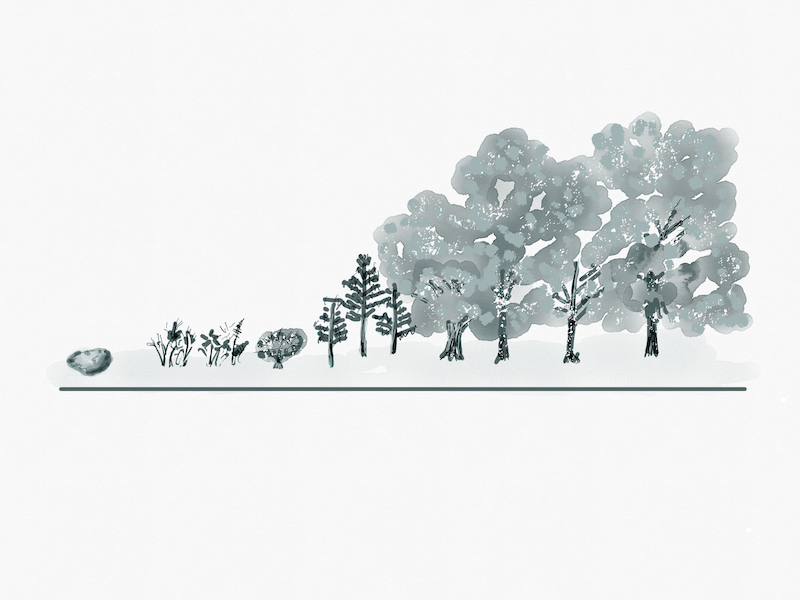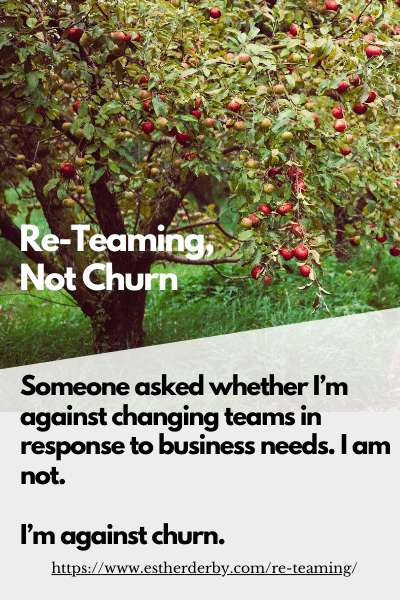In ecology, the process through which rocky ground becomes a forest is referred to as forest succession. I’m married to an ecologist, so I hear a lot about such things, and it occurred to me that we can learn about how to create sustainable change in our organizations by looking at how forests come to be.
Here’s the thing about forests. You can’t plant a forest on rocky ground. It doesn’t work.
Forests emerge when the conditions are right for forests. But it doesn’t start with something that looks like a forest. Before there’s a mature forest, there are many intermediate stages, each of which becomes possible because of an alteration in the environment—and which itself alters the environment in some way, making the next stage possible.
The way people talk about change often makes it sound like it is a clear step-wise process. Design a process. Train people in the process. Voila. People do the process. We sometimes talk about change as if we were screwing in a light bulb. Too many organizational changes take this approach—install a fully formed process into an existing organization, and everything is supposed to work. Except that often it does not, and the existing pattern reasserts itself.
The conditions aren’t conducive to the new way of working, partly because the factors that created the old patterns are still in place and need to be addressed. But also because the patterns of thought, attitudes and skills needed for the new way of working aren’t there yet.
So let’s look at forest succession.
Forest succession is a natural process, but it is also one that can be aided by careful human intervention.
Each Change Creates the Conditions for the Next
Whatever you plant will affect the environment. Perhaps loosening the soil, depositing nitrogen, removing other nutrients. In nature, the grasses and weeds are often the first to start on rocky land. They may hold a little moisture in the soil, making it possible for another plant community to take root. Those plants may create a bit of shade, which will affect the humidity. The shade will encourage some new plants, but discourage others. Eventually larger herbaceous plants and shrubs take hold. Then, trees begin to take hold. The trees create shade, which causes sun-loving plants in the understory to die off.
There’s not a clear delineation between each phase. They blend and overlap; one state begins to emerge, and as it takes hold the other fades. You can see the change early if you pay attention. But if you’re not observant, you might not notice until the progression is well underway.
In nature, this process can take many decades. But horticulturalists and ecologists can speed up the process. So they study the soil composition, nutrient level, water level, air temp, humidity, and rainfall patterns. They may ameliorate the soil. Then, they choose plants that can thrive and survive in that environment—knowing they will change it. They add new plants over time as the environment changes. With diligent care, watering and weeding, some people have established self-maintaining prairies or forests within a few years.

Starting with the end in mind isn’t bad advice, but it leaves something out—it leads people to gloss over where you actually begin. No matter where you want to go, you start from where you are. You start from the skills, capabilities, assumptions, and mental models that currently exist in your organization.
What is Possible Now, What is Possible Next
Trying to plant something that cannot survive in the existing environment is futile. So it is with change. The first step is to find something that can exist NOW, yet will move in the desired direction.
Each small change—a new skill or behavior, method, shift in perspective—has an impact on the organization. It alters the organization in some subtle or other way. That alteration makes it possible for another change to take hold.
I usually come at this from two directions. First thinking backwards and THEN thinking forwards.
First I think backwards from where the organization wants to be. This helps establish what must be true to support what the organization aspires to. And then I look for intermediate states leading up to it.
I work backwards until I find a place where people can take tangible action now, and start working on small changes that will create the environment for the next thing to emerge.
I also use landing zones. These help identify intermediate states, looking forward. They are very useful when achieving the desired outcome seems unattainable or overwhelming. Landing zones provide an intermediate goal, so that people have some sense of accomplishment and progress. They also provide a little place to pause, reassess and make plans to reach the next zone.
Say an organization has a bunch of critical customer incidents that are costing penalties. They want to reduce these incidents to 0. A lovely aspiration. But not very helpful in actually getting there.
Break Down Overwhelming Changes into Tiny Next Steps
This was the case in an organization I worked with. The problem was so big it felt overwhelming. So I helped them describe the current situation, and look at what they had control over. Then they defined a goal that seemed attainable, an improvement they could make with what they knew, who they had, and the material resources at hand.
In this case, the next best step was having an accurate understanding of the quality of their system. That helped identify a number of tangible actions that included improving testing and shoring up their build process. It didn’t get them to 0 critical incidents. but it prepared the ground for the next landing zone.
The landing zone looks at what is, and identifies the next best thing. What would be slightly better. It’s much easier to break down the differences and the skills, infrastructure and knowledge that will get you there when you think of it in smaller steps.
These two ways of approaching a problem or an aspiration enable people to focus on creating conditions. Each step alters the system, making it possible for the next step, until they achieve the outcome. They may still do training, define new processes and practices… But they aren’t trying to plant their forest on rocky ground. They’re preparing the way—and learning—as they go.
You aren’t growing a forest—but you can learn something from forest succession.
While you keep an eye on the goal, also think about preparing the metaphorical ground.
Look at factors that hold the pattern in place. Which will interfere, hinder or prevent the change from taking hold?
Look for what can take hold now, and that can be a tiny step in the desired direction.
Back chain from the complex tasks involved in a new way of working. What are the fine-grained skills that build up to that?
Start with the smallest leap.
When you work this way, it’s far more likely that you’ll achieve sustainable change.
Listen to the Change by Attraction podcast.







Thanks for helping us to think in baby steps so our goal is not overwhelming
wonderful experience